Polypropylene pipes for heating - specifications and features of choice
Plumbing from polypropylene pipes from a rare exotic has long become commonplace. In terms of cost, durability and reliability, polypropylene is the undisputed leader among modern materials. Can these pipes be used in heating systems?
Features of operation in heating systems
What is the fundamental difference in terms of pipe requirements between a cold water supply and a heating system?
- The pressure in the heating system is on average twice as high: 6 kgf / cm2 versus 3-3.5.
However: in the presence of house pumping, the pressure on cold water can reach the same 6 atmospheres, or even greater values.
- The temperature, according to regulatory documents, can reach 95-105 degrees, depending on the type of heating system. Let's remember these keywords: according to the norms. As we shall see, the reality may differ from them.
- During the year, the temperature of the coolant and, accordingly, the pipes will change from room temperature to those very threshold values. What does this mean for pipes? Thermal expansion. It will have to be taken into account.
Material Features
Now consider the situation from the other side.
What are the physical and chemical properties of polypropylene?
- The material has the lowest density among all plastics - only 0.91 kg / cm2. At the same time, it is very hard and resistant to abrasion. For us, this means that we can not be afraid of the rapid wear of pipes by abrasive particles, which will inevitably be present in the coolant. We give the material a plus.
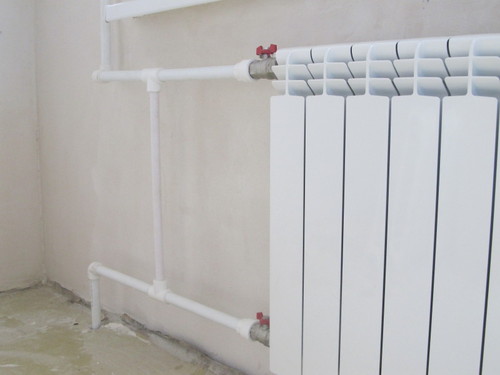
Water in the heating system carries sand and pieces of slag, but polypropylene is not afraid of them.
- Mechanical strength depends on the rate of force application. Simply put, if you sharply bend the pipe, it can break. If you apply the same force, increasing it gradually, slowly, the pipe will bend. Another plus: the loads during operation will be associated with linear expansion during heating and, therefore, will be applied to the pipe material extremely slowly.
- Resistance to aggressive substances is quite high: only a combination of contact with concentrated acid and prolonged heating will lead to surface destruction. Another plus in our collection, since hot water often contains additives that reduce the corrosion damage of steel pipes and the amount of deposits.
- Frost resistance - -5 - 15 degrees depending on the stabilizing additives. Perhaps, for our purposes, this information is neutral: when the heating system is operating, the temperature in the room should not fall below zero, and even more so the temperature of the coolant will not fall below zero.
- The melting point of the material is 160 - 170 degrees.
- Softening temperature - 140.
- Maximum operating temperature - 120 for all polypropylene products.
It seems that our immoderate enthusiasm about the properties of the material was unjustified. Or not? We will analyze the situation a little later; now we will pay attention to another important property of polypropylene.
See here.
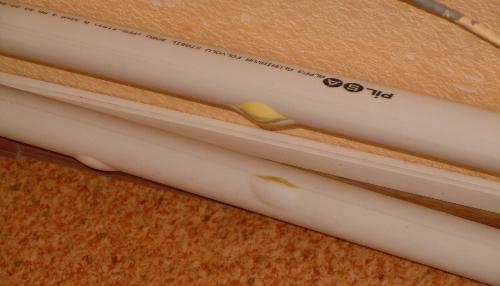
- Polypropylene has a very high coefficient of thermal expansion. It is equal to 0.15 mm / m * C. A simple calculation shows that a three-meter straight pipe section between the floor and the ceiling, heated from 20 to 90 degrees, will lengthen by 0.15 * 3 * (90-20) = 31.5 millimeters.
An extension of more than three centimeters will mean that the pipe will not only be bent - it will bend in the manner of a stretched bow. Another big and very significant minus of the material.
The devil is in the details
Reinforcement
The problem of thermal expansion of polypropylene has long had a simple and effective solution - pipe reinforcement. A material with a lower coefficient of thermal expansion performs the function of stabilizing linear dimensions. As a result, thermal expansion is reduced by a factor of five - to 0.03 mm/m*C.
Pipes are reinforced in two main ways:
- aluminum foil. The aluminum-reinforced pipe is a glued three-layer sandwich in which a thin aluminum layer is hidden between the layers of polypropylene. These pipes are highly dependent on the quality of manufacture and, if the technology is violated, they easily delaminate.
- Fiberglass reinforced pipes, on the other hand, are monolithic construction: the fiber layer is located directly in the thickness of the polypropylene pipe. These pipes do not delaminate; in addition, when welded, they do not require stripping of the reinforcing layer.
Both types of reinforcement are perfect for heating systems. However, it must be taken into account that reinforcement does not deprive polypropylene of thermal expansion - it only reduces it, while simultaneously increasing the pipe's ability to withstand pressure.

Heat carrier temperature
We remember what the regulatory documents promise. But does the heating temperature always comply with regulatory documents?
Several factors influence the interaction of pipes and water temperature.
- Most manufacturers guarantee the operation of pipes at temperatures up to 90 - 95 degrees.
- According to the current temperature charts in Russia, the upper limit - 95 - 105 degrees - the temperature of the coolant reaches only in severe frosts. At 30 - 40 degrees, which in a significant part of the country's territory is either unattainable or is an exception.
- On the other hand, at 95C in the heating system, the temperature on the supply pipe of the heating main reaches 140C.
In case of extremely severe frosts, violation of the temperature schedule by thermal workers and a large number of complaints from residents, a simple and crude solution to the heat problem is practiced: a nozzle is pulled out in the elevator unit, which regulates the temperature of the water in the heating system, and the suction is suppressed.
Water from the supply heating main enters the risers and heating radiators directly. With the temperature that is not just dangerous for polypropylene - destructive.
Read here.
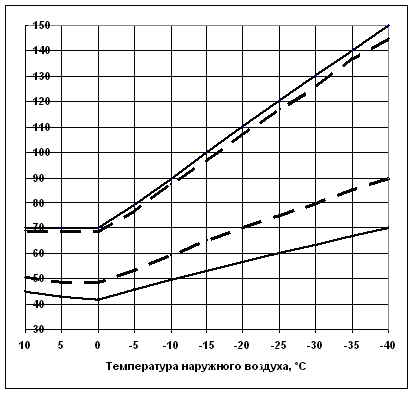
conclusions
They come down to this:
- Polypropylene pipes should not be used in heating systems in those regions that are characterized by severe frosts in winter. If your average January temperature is below -25, it would be wise to opt for galvanized steel or stainless steel pipes.
- Only reinforced pipes should be used in both hot water supply systems and heating systems. Reinforcement with both aluminum and fiber is equally applicable; in the second case, the installation of pipes on welded joints is somewhat simplified. If you assemble the heating system yourself, you will not need a stripping tool. At the same time, the price of a running meter of pipes with different types of reinforcement differs extremely slightly and in an unpredictable way.
- When installing heating systems with polypropylene, it is necessary to avoid placing pipes in spacers between walls or ceilings. There must always be clearances for thermal expansion.
The same applies to laying pipes in the floor or walls. In addition, with a large length of the straight section of the pipe, so-called expansion joints are made: annular turns of the pipe or U-shaped brackets, which, when elongated, allow the pipe not to bend in an arc.
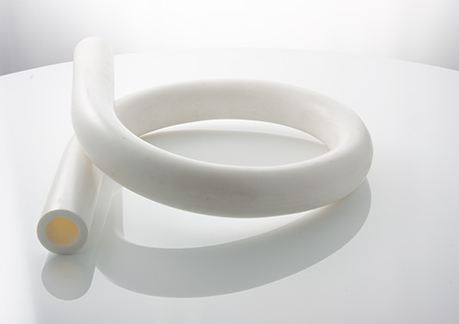
The simplest compensator is a pipe coil.
Criterias of choice
And now, in fact, we have come close to the problem of choosing pipes for heating. What should you pay attention to when buying? We will need as detailed instructions as possible.
Pressure
The marking of the type PN ** is directly related to the working pressure of the pipe. After the letters, two numbers indicate the maximum working pressure for which the pipes are designed, in atmospheres.
Nuance: the working pressure is indicated for a temperature of 20C. At 80-90, it can be safely divided into three, so it is better to choose PN25 pipes. However, this is more of a reinsurance: PN20 pipes are massively used for heating and do not create problems for the owners.
Temperature
The maximum operating temperature is also usually included in the pipe markings. Most manufacturers indicate either 90 or 95C for reinforced pipes. From the point of view of the consumer, these values are equivalent: one of the manufacturers is simply more insulating itself from possible lawsuits.
Diameter
To accurately calculate the required diameter, builders use rather complex formulas that take into account the heat load, the temperature difference between supply and return (which in the case of district heating depends on the CHP), the roughness coefficient of the pipe material, the color of the rising Venus and the phase of the moon.
However, from a practical point of view, it is enough to remember two simple rules:
- When distributing heating around the apartment, the polypropylene pipes used should not underestimate the clearance relative to the risers. Most new houses use DN20 (3/4 inch) pipe risers; accordingly, you will need a polypropylene pipe with an outer diameter of 26 millimeters). In steel pipes with inch risers, it would be wise to use pipes with an outer diameter of 32 mm.
- For a private house with an area of up to 250 square meters, the most efficient and trouble-free heating system is Leningradka (a pipe ring around the perimeter of the house on each floor, parallel to which, without breaking it, heaters are embedded). For the ring, a pipe with a diameter of 32-40 is taken, for inserting radiators - 20 - 26 millimeters.
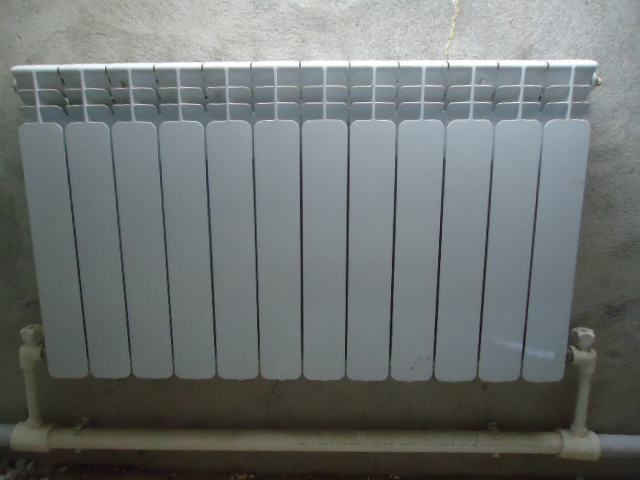
Manufacturers
Here, the study of forums with customer reviews will help.
If we omit all the verbose enthusiasm and outpourings, the bottom line will be approximately the following rating (in descending order of popularity):
- Valtec;
- Firat;
- FV-Plast;
- Banninger;
- Ecoplastic;
- Tebo.
Surely there are other manufacturers that are not included in the list, but offer quality products at reasonable prices. A simple search on the Internet by the name of the manufacturer will help you.
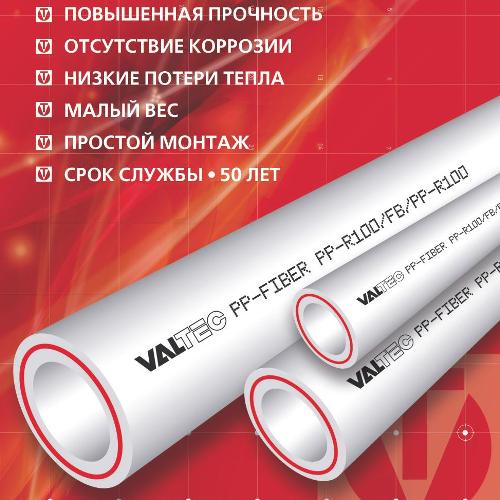
Conclusion
You will find additional information on the use of polypropylene pipes in heating systems in the video at the end of the article. Warm winters!
